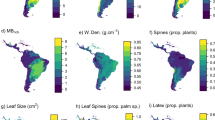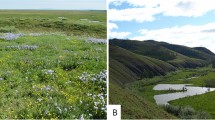Abstract
The Cape Peninsula, a 470 km2 area of rugged scenery and varied climate, is located at the southwestern tip of the Cape Floristic Region, South Africa. The Peninsula is home to 2285 plant species and is a globally important hot-spot of biodiversity for higher plants and invertebrates. This paper provides a broad overview of the physiography, biological attributes and history of human occupation of the Peninsula. The Peninsula is characterized physiographically by extremely high topographical heterogeneity, very long and steep gradients in annual rainfall, and a great diversity of nutrient-poor soils. Thus, the Peninsula supports a high number of habitats and ecological communities. The predominant vegetation is fynbos, a fire-prone shrubland, and 12 broadly characterized fynbos types have been described on the Peninsula. Animal community structure, especially with regard to invertebrates, is poorly known. Vertebrate community structure is probably strongly influenced by nutrient poverty and recurrent fire. Generally, most vertebrates are small and typically occur in low numbers. Some invertebrates play keystone roles in facilitating ecological processes. Human occupation of the Peninsula was limited, until relatively recently, by nutrient poverty. After Dutch colonization in 1652, direct and indirect impacts on the natural ecosystems of the Peninsula escalated dramatically, and by 1994, some 65% of original natural habitat was either transformed by urbanization and agriculture, or invaded by alien plants. Nonetheless, there is still excellent potential to conserve the Cape Peninsula's remaining biodiversity.
Similar content being viewed by others
References
Adamson, R.S. (1927) The plant communities of Table Mountain. I. Preliminary account. J. Ecol. 15. 278–309.
Adamson, R.S. and Salter, T.M. (eds) (1950) Flora of the Cape Peninsula. Cape Town: Juta.
Bolton, J.J. and Anderson, R.S. (1996) Marine vegetation. In Vegetation of Southern Africa (R.M. Cowling, D.M. Richardson and S.M. Pierce, eds). Cambridge: Cambridge University Press (in press).
Bond, W.J. (1984) Fire survival of Cape Proteaceae—influence of fire season and seed predators. Vegetatio 56, 65–74.
Bond, W.J. and Stock, W.D. (1990) The costs of leaving home: ants disperse seeds to low nutrient sites. Oecologia 81, 412–17.
Bond, W.J., Yeaton, R.I. and Stock, W.D. (1991) Myrmecochory in Cape fynbos. In Ant-plant Interactions (C. Huxley and D. Cutler, eds) pp. 448–62. Oxford: Oxford University Press.
Campbell, B.M. (1986) Montane plant communities of the fynbos biome. Vegetatio 66, 3–16.
Campbell, B.M. and Moll, E.J. (1977) The forest communities of Table Mountain, South Africa. Vegetatio 34, 105–15.
Christopher, A.J. (1976) Southern Africa. Folkestone: Dawson.
Cowling, R.M. (1990) Diversity components in a species-rich area of the Cape Floristic Region. J. Veg. Sci. 1, 699–710.
Cowling, R.M. (ed.) (1992) The Ecology of Fynbos. Nutrients, Fire and Diversity. Cape Town: Oxford University Press.
Cowling, R.M. and Holmes, P.M. (1992) Flora and vegetation. In The Ecology of Fynbos. Nutrients, Fire and Diversity (R.M. Cowling ed.) pp. 23–61. Cape Town: Oxford University Press.
Cowling, R.M., Holmes, P.M. and Rebelo, A.G. (1992) Plant diversity and endemism. In The Ecology of Fynbos. Nutrients, Fire and Diversity (R.M. Cowling, ed.) pp. 62–112. Cape Town: Oxford University Press.
Cowling, R.M., Richardson, D.M., Shultze, R.E., Hoffmann, M.T., Midgley, J.J. and Hilton-Taylor, C. (1966) Species richness at the regional scale. In Vegetation of Southern Africa (R.M. Cowling, D.M. Richardson and S.M. Pierce, eds). Cambridge: Cambridge University Press (in press).
Deacon, H.J. (1983) An introduction to the fynbos region, time-scales and palaeoenvironments. In Fynbos Palaeoecology: a Preliminary Synthesis (H.J. Deacon, Q.B. Hendey and J.J.N. Lambrechts, eds) pp. 1–20. South African National Programmes Report 75. Pretoria: CSIR.
Deacon, H.J. (1992) Human settlement. In The Ecology of Fynbos. Nutrients, Fire and Diversity (R.M. Cowling, ed.) pp. 260–70 Cape Town: Oxford University Press.
Deacon, H.J., Hendey, Q.B. and Lambrechts, J.J.N. (eds) (1983) Fynbos Palaeoecology: a Preliminary Synthesis. South African National Scientific Programmes Report 75 Pretoria: CSIR.
Deacon, H.J., Jury, M.R. and Ellis, F. (1992) Selective regime and time. In The Ecology of Fynbos. Nutrients, Fire and Diversity (R.M. Cowling, ed.) pp. 6–22. Cape Town: Oxford University Press.
Elphick, R. (1985) Khoikhoi and the Founding of White South Africa. Johannesburg: Ravan Press.
Emanuel, B.P., Bustamente, R.H., Branch, G.M., Eekout, S. and Oodendaal, F.J. (1992) A zoogeographic and functional approach to the selection of marine reserves on the west coast of South Africa. S. Afr. J. Mar. Sci. 12 341–54.
Fraser, M. (1990) Effects of natural vegetation, fire and alien plant invasion on bird species assemblages in mountain fynbos of the south western Cape Province, South Africa. Unpublished MSc. thesis, University of Cape Town.
Fraser, M. (1996) Bishops and Baboons: a Guide to the Wildlife of the Cape of Good Hope Nature Reserve. Johannesburg: Southern African Ornithological Society.
Fraser, M. and McMahon, L. (1994) Between Two Shores. Flora and Fauna of the Cape of Good Hope. Cape Town: David Philip.
Gentry, A.H. (1986) Endemism in tropical versus temperate plant communities. In Conservation Biology. The science of Scarcity and Diversity (M. Soule, ed.) pp. 153–81. Sunderland, MA: Sinauer Press.
Glyphis, J., Moll, E.J. and Campbell, B.M. (1978) Phytosociological studies on Table Mountain, South Africa. 1. The Back Table. J. S. Afr. Bot. 44, 281–9.
Goldblatt, P. (1978) An analysis of the flora of southern Africa: its characteristics, relationships, and origins. Ann. Missouri Bot. Gard. 65, 369–436.
Freydorn, A.E.F. and Tinley, K.L. (1980) Estuaries of the Cape. Part 1. Synopsis of the Cape Coast—Natural Features, Dynamics and Utilization. Stellenbosch: CSIR.
Hockey, P.A.R., Underhill, L.G., Neatherway, M. and Ryan, P.G. (1989) Atlas of Birds of the Southwestern Cape. Cape Town: Cape Bird Club.
Johnson, S.D. (1992a) Plant-animal relationships. In The Ecology of Fynbos. Nutrients, Fire and Diversity. (R.M. Cowling, ed.) pp. 175–205. Cape Town: Oxford University Press.
Johnson, S.D. (1992b) Habitat dependent pollination in a Cape orchid. Oecologia 91, 455–6.
Johnson, S.D. and Bond, W.D. (1994) Red flowers and butterfly pollination in the fynbos of South Africa. In Plant-animal Interactions in Mediterranean-type Ecosystems (M. Arianoutsou and R.H. Groves, eds) pp. 137–48. Dordrecht: Kluwer.
Joubert, C. and Moll, E.J. (1992) A phytosociological study of Signal Hill, Cape Town, utilizing both perennial and ephemeral species. Bothalia 22, 255–82.
Knight, R.S. (1988) Aspects of plant dispersal in the south-western Cape with special reference to the roles of birds as dispersal agents. Unpublished PhD thesis, University of Cape Town.
Kruger, F.J. (1979) South African heathlands. In Heathlands of the World. A Descriptive Studies (R.L. Specht, ed.) pp. 19–84. Amsterdam: Elsevier.
Kruger, F.J. and Taylor, H.C. (1979) Plant species diversity in Cape fynbos: gamma and delta diversity. Vegetatio 47, 85–93.
Laidler, D., Moll, E.J., Campbell, B.M. and Glyphis, J. (1978) Phytosociological studies on Table Mountain, South Africa: 2. The Front Table. J. S. Afr. Bot. 44, 291–5.
Lovegrove, B.G. and Jarvis, J.U.M. (1986) Coevolution between molerats (Bathyergidae) and a geophyte, Micranthus (Iridaceae). Cimbebasia 8, 79–85.
Luckhoff, C.A. (1951) Table Mountain. Cape Town: A.A. Balkema.
Macdonald, I.A.W., Graber, D.M., DeBenedetti, S., Groves, R.H. and Fuentes, E.R. (1988) Introduced species in nature reserves in Mediterranean-climate regions of the world. Biol. Conserv. 44, 37–66.
Marloth, R. (1905) Results of further experiments on Table Mountain for ascertaining the amounts of moisture deposited from south-east clouds. Trans. S Afr. Phil. Soc. 16 97–105.
McKenzie, B., Moll, E.J. and Campbell, B.M. (1977) A phytosociological study of Orange Kloof, Table Mountain, South Africa, Vegetatio 34, 41–53.
Moll, E.J. and Bossi, L. (1984) Assessment of the extent of natural vegetation of Fynbos Biome of South Africa. S. Afr. J. Sci. 81, 355–8.
Moll, E.J. and Campbell, B.M. (1976) The ecological status of Table Mountain—a report on the present conservation status with recommendations for the future management of the National Monument. Department of Botany, University of Cape Town.
Myers, N. (1990) The biodiversity challenge: expanded hot-spot analysis. Environmentalist 8, 1–20.
Picker, M.D. and Samways, M.J. (1996) Faunal diversity and endemicity of the Cape Peninsula, South Africa—a first assessment. Biodiv. Conserv. 5, 591–606.
Rebelo, A.G. (ed) (1987) A preliminary synthesis of pollination biology in the Cape flora. S. Afr. Nat. Sci. Prog. Rep. 141. Pretoria: SCIR.
Richardson, D.M., Macdonald, I.A.W., Holmes, P.M. and Cowling, R.M. (1992) Plant and animal invasions. In The Ecology of Fynbos. Nutrients, Fire and Diversity (R.M. Cowling, ed.) pp. 270–308. Cape Town: Oxford University Press.
Richardson, D.M., Cowling, R.M., Bond, W.J., Stock, W.D. and Davis, G.W. (1995) Links between biodiversity and ecosystem function in the Cape Floristic Region. In Mediterranean-type Ecosystems. The Function of Biodiversity (G.W. Davis and D.M. Richardson, eds) pp. 285–333. Berlin: Springer-Verlag.
Richardson, D.M., van Wilgen, B.W., Higgins, S.I., Trinder-Smith, T.H., Cowling, R.M. and McKelly, D.H. (1996) Current and future threats to plant biodiversity on the Cape Peninsula, South Africa. Biodiv. Conserv. 5, 607–47
Siegfried, W.R. (1983) Trophic structure of some communities of fynbos birds. S. Afr. J. Bot. 49, 1–43.
Skead, C.J. (1980) Historical Mammal Incidence in the Cape Province, Vol. 1. Cape Town: Dept. Nature and Environmental Conservation.
Simmons, M.T. and Cowling, R.M. (1996) Why is the Cape Peninsula so rich in plant species? An analysis of the independent diversity components. Biodiv. Conserv. 5, 551–73
Snow, C. (1985) Mist interception by three species of mountain fynbos. Unpublished M.Sc. thesis. University of Cape Town.
Taylor, H.C. (1969) A vegetation survey of the Cape of Good Hope Nature Reserve. Unpublished M.Sc. thesis, University of Cape Town.
Taylor, H.C. (1978) Capensis. In Biogeography and Ecology of Southern Africa (M.J.A. Werger ed.) pp. 171–229. The Hague: Junk.
Taylor, H.C. (1984) Vegetation survey of the Cape of Good Hope Nature Reserve. II. Descriptive account. Bothalia 15, 259–91.
Thom, H.B. (1952) Journal of Jan van Riebeek 1. Cape Town: Balkema.
Theron, J.N., Gresse, P.G., Siegfried, H.P. and Rogers, J. (1992) The Geology of the Cape Town Area. Pretoria: Government Printer.
Trinder-Smith, T.H. (1995) Flora of the Cape Peninsula: endemism, threatened plants and conservation in perspective. Unpublished M.Sc. thesis, University of Cape Town.
Trinder-Smith, T.H., Cowling, R.M. and Linder, H.P. (1996a) Profiling a besieged flora: endemic and threatened plants of the Cape Peninsula, South Africa. Biodiv. Conserv. 5, 575–89
Trinder-Smith, T.H., Lombard, A.T. and Picker, M. (1996b) Reserve scenarios for the Cape Peninsula: high, middle and low road options for conserving the remaining biodiversity. Biodiv. Conserv. 5, 649–69
UCT (1994) Policy for multipurpose use of the Cape Peninsula. Volume 1. Main Report. Cape Town: University of Cape Town.
van Hensbergen, H.J., Botha, S.A., Forsyth, G.G. and Le Maitre, D.C. (1992) Do small mammals govern vegetation recovery after fire in fynbos? In Fire in South African Mountain Fynbos (B.W. van Wilgen, D.M. Richardson, F.J. Kruger and H.J. van Hensbergen, eds.) pp. 182–202. Berlin: Springer-Verlag.
van Wilgen, B.W. (1996) Management of the natural ecosystems of the Cape Peninsula: current status and future prospects. Biodiv. Conserv. 5, 671–84
Wright, M.G. (1988) A note on the reaction of angulate tortoises to fire in fynbos. S. Afr. J. Wildl. Res. 18, 131–3.
Wright, M.G., Visser, D. and de Lange, J.H. (1991) Autecological studies on Audouinia capitata (Bruniaceae). 2. Insects as pollinator vectors. S. Afr. J. Bot. 57, 260–3.
Zumpt, I.F. and Heine, E.W.P. (1978) Some veterinary aspects of Bontebok in the Cape of Good Hope Nature Reserve. S. Afr. J. Wildl. Res. 8, 131–4.
Author information
Authors and Affiliations
Rights and permissions
About this article
Cite this article
Cowling, R.M., MacDonald, I.A.W. & Simmons, M.T. The Cape Peninsula, South Africa: physiographical, biological and historical background to an extraordinary hot-spot of biodiversity. Biodivers Conserv 5, 527–550 (1996). https://doi.org/10.1007/BF00137608
Received:
Accepted:
Issue Date:
DOI: https://doi.org/10.1007/BF00137608




